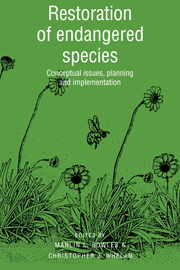Book contents
- Frontmatter
- Contents
- List of contributors
- Foreword
- Acknowledgments
- I Conceptual issues in restoration ecology
- II Restoration planning
- 6 Impacts of biological invasions on the management and recovery of rare plants in Haleakala National Park, Maui, Hawaii
- 7 Disturbance-dependent persistence of rare plants: anthropogenic impacts and restoration implications
- 8 A metapopulation approach to Pitcher's thistle (Cirsium pitcheri) recovery in southern Lake Michigan dunes
- 9 Restoration of woodland caribou to the Lake Superior region
- III Implemented restorations
- IV Synthesis and future directions: biology, politics and reality
- Taxonomic Index
- Subject Index
6 - Impacts of biological invasions on the management and recovery of rare plants in Haleakala National Park, Maui, Hawaii
Published online by Cambridge University Press: 27 January 2010
- Frontmatter
- Contents
- List of contributors
- Foreword
- Acknowledgments
- I Conceptual issues in restoration ecology
- II Restoration planning
- 6 Impacts of biological invasions on the management and recovery of rare plants in Haleakala National Park, Maui, Hawaii
- 7 Disturbance-dependent persistence of rare plants: anthropogenic impacts and restoration implications
- 8 A metapopulation approach to Pitcher's thistle (Cirsium pitcheri) recovery in southern Lake Michigan dunes
- 9 Restoration of woodland caribou to the Lake Superior region
- III Implemented restorations
- IV Synthesis and future directions: biology, politics and reality
- Taxonomic Index
- Subject Index
Summary
Introduction
Biological invasions assisted by humans are impoverishing biological diversity worldwide (MacDonald et al. 1989, Diamond 1989). Such invasions are particularly devestating to the biota of oceanic islands such as Hawaii (Williamson 1981, Brockie et al. 1988, Hawaii Department of Land and Natural Resources et al. 1991). Ecosystems of the Hawaiian Islands are much more vulnerable to biological invasions than are continental ecosystems, because the organisms in them have evolved in isolation from many of the forces that have shaped continental organisms, including foraging and trampling by herbivorous mammals, predation by ants and mammals, virulent diseases, and fires (Loope & Mueller–Dombois 1989). Lowland ecosystems of the Hawaiian Islands were substantially modified by Polynesians prior to western contact (Kirch 1982); after Cook's ‘discovery’ of the islands in 1778, the rate of modification accelerated and extended to higher elevations (Cuddihy & Stone 1990).
Ecosystems of low and middle elevations of the Hawaiian Islands have been drastically altered. Biological diversity has eroded more rapidly in Hawaii than in any other state. Though only 19 Hawaiian plant species have been federally designated as Endangered (US Fish and Wildlife Service 1990), it is estimated that of 1094 Hawaiian native taxa of flowering plants, 10% are extinct, 12% endangered, 4% vulnerable, and 12% rare (Wagner, Herbst & Sohmer 1990). Many Hawaiian botanists consider these figures conservative. Several conservation groups filed suit against the US Fish and Wildlife Service for listing few of the eligible Hawaiian species, and the Service agreed to propose 186 more species for listing by late 1992 (Anonymous 1990).
- Type
- Chapter
- Information
- Restoration of Endangered SpeciesConceptual Issues, Planning and Implementation, pp. 143 - 158Publisher: Cambridge University PressPrint publication year: 1994
- 9
- Cited by



